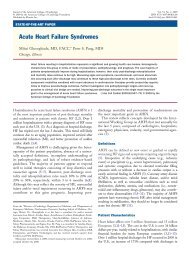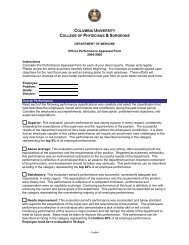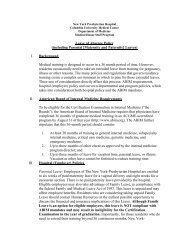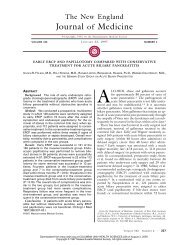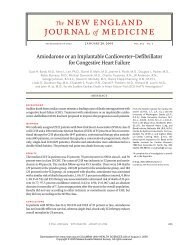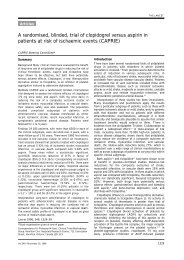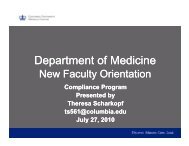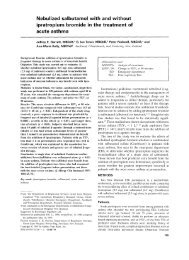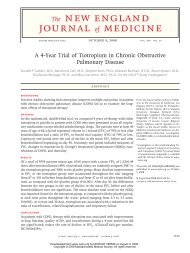Acute Hemodynamic Effects of Octreotide and Terlipressin in ...
Acute Hemodynamic Effects of Octreotide and Terlipressin in ...
Acute Hemodynamic Effects of Octreotide and Terlipressin in ...
You also want an ePaper? Increase the reach of your titles
YUMPU automatically turns print PDFs into web optimized ePapers that Google loves.
634 Baik et al.<br />
DISCUSSION<br />
<strong>Octreotide</strong> <strong>and</strong> terlipress<strong>in</strong> are both synthetic longer-act<strong>in</strong>g<br />
analogues <strong>of</strong> the vasoconstrictor hormones somtatostat<strong>in</strong><br />
<strong>and</strong> vasopress<strong>in</strong>, respectively. Moreover, both drugs reportedly<br />
decrease portal flow <strong>and</strong> pressure <strong>and</strong> are therefore<br />
used commonly to medically tamponade bleed<strong>in</strong>g gastroesophageal<br />
varices. However, beyond these similarities, it is<br />
now clear that these drugs behave very differently <strong>in</strong> many<br />
respects. The literature on their efficacy <strong>in</strong> bleed<strong>in</strong>g varices<br />
rema<strong>in</strong>s somewhat controversial, but recent reviews have<br />
suggested that some <strong>of</strong> the discrepancies result from <strong>in</strong>appropriately<br />
lump<strong>in</strong>g together octreotide <strong>and</strong> somatostat<strong>in</strong>,<br />
<strong>and</strong> terlipress<strong>in</strong> <strong>and</strong> vasopress<strong>in</strong>, for metaanalytic reviews.<br />
More recent reviews <strong>in</strong>clud<strong>in</strong>g a Cochrane systematic review<br />
have avoided this mistake, correctly consider<strong>in</strong>g each <strong>in</strong>dividual<br />
drug by itself (3, 22). When analyzed <strong>in</strong> this manner,<br />
octreotide efficacy <strong>in</strong> acute variceal bleed<strong>in</strong>g still rema<strong>in</strong>s<br />
unclear, whereas terlipress<strong>in</strong> is clearly an effective<br />
hemostatic agent (22). Moreover, <strong>in</strong> the Cochrane systematic<br />
review by Ioannou <strong>and</strong> colleagues, terlipress<strong>in</strong> was identified<br />
as the only drug that significantly improved mortality<br />
(3).<br />
Even the acute hemodynamic studies <strong>of</strong> octreotide show<br />
discrepant results. Some studies report a beneficial effect on<br />
portal hemodynamics whereas others do not (8–12). In part,<br />
this may relate to the variable tim<strong>in</strong>g <strong>of</strong> the hemodynamic<br />
measurements after drug adm<strong>in</strong>istration. In that regard, the<br />
immediate-early hemodynamic effects <strong>of</strong> octreotide are almost<br />
unstudied, with one notable exception (8). That exception<br />
is the study by Escorsell <strong>and</strong> colleagues (8), <strong>and</strong> the current<br />
results show a very similar transient pattern <strong>of</strong> octreotide<br />
effect on portal pressure <strong>and</strong> systemic hemodynamics. Additionally,<br />
we found that the transient portal pressure drop<br />
is directly proportionately related to a decrease <strong>in</strong> PVF, suggest<strong>in</strong>g<br />
that the portal-hypotensive effect is entirely due to<br />
mesenteric vasoconstriction, rather than chang<strong>in</strong>g upstream<br />
<strong>in</strong>trahepatic resistance sites.<br />
The exact mechanism <strong>of</strong> the rapid desensitization <strong>of</strong> the<br />
hemodynamic effect rema<strong>in</strong>s unclear. <strong>Octreotide</strong> has been<br />
postulated to act by <strong>in</strong>hibit<strong>in</strong>g secretion <strong>of</strong> glucagons <strong>and</strong><br />
other gastro<strong>in</strong>test<strong>in</strong>al vasodilatory peptides (23, 24). However,<br />
the very brief hemodynamic effect <strong>of</strong> the bolus octreotide<br />
contrasts with the prolonged suppression <strong>of</strong> glucagon<br />
secretion, which persists for many hours (8). This suggests<br />
that octreotide <strong>in</strong>duces a direct systemic <strong>and</strong> splanchnic vasoconstriction.<br />
Indeed, recent studies have shown that octreotide<br />
directly vasoconstricts forearm vessels <strong>in</strong> cirrhotic patients,<br />
<strong>in</strong>dependent <strong>of</strong> the systemic hormonal effect <strong>of</strong> glucagons<br />
(25).<br />
Previous studies have shown that octreotide also exerts a<br />
systemic effect with <strong>in</strong>creased MAP <strong>and</strong> vascular resistance<br />
(8, 24, 26–29). This systemic effect was also observed <strong>in</strong> the<br />
present study, albeit aga<strong>in</strong> only <strong>in</strong> the immediate-early period,<br />
with rapid desensitization. Whatever the exact mechanism,<br />
this rapid desensitization raises doubt about the usefulness <strong>of</strong><br />
octreotide <strong>and</strong> may expla<strong>in</strong> the variability <strong>in</strong> previous studies<br />
about its efficacy <strong>in</strong> the management <strong>of</strong> acute variceal<br />
bleed<strong>in</strong>g.<br />
In contrast to octreotide, the hemodynamic effects <strong>of</strong> terlipress<strong>in</strong><br />
<strong>in</strong> our study were susta<strong>in</strong>ed. We know from previous<br />
studies that after a s<strong>in</strong>gle <strong>in</strong>travenous bolus <strong>of</strong> terlipress<strong>in</strong>, the<br />
hemodynamic effects persist between 30–240 m<strong>in</strong> (13–17).<br />
Aga<strong>in</strong>, the immediate-early period <strong>in</strong>clud<strong>in</strong>g 1 m<strong>in</strong> postdose<br />
has not been extensively studied. Romero <strong>and</strong> colleagues reported<br />
some measurements from the 3–60 m<strong>in</strong> <strong>in</strong>terval after<br />
terlipress<strong>in</strong> bolus adm<strong>in</strong>istration <strong>in</strong> 13 patients (30). We previously<br />
reported the portal hypotensive effect <strong>of</strong> terlipress<strong>in</strong><br />
<strong>in</strong> 43 patients from the 5–30 m<strong>in</strong> <strong>in</strong>terval postdose (18).<br />
What is the cl<strong>in</strong>ical relevance <strong>of</strong> these short-term hemodynamic<br />
data Besides the reduction <strong>in</strong> portal <strong>in</strong>flow <strong>and</strong><br />
pressure, the other possible mechanisms <strong>of</strong> octreotide <strong>in</strong> the<br />
control <strong>of</strong> acute variceal bleed<strong>in</strong>g <strong>in</strong>clude reduc<strong>in</strong>g postpr<strong>and</strong>ial<br />
splanchnic hyperemia <strong>and</strong> azygos ve<strong>in</strong> flow, which were<br />
not assessed <strong>in</strong> the present study. Therefore, we cannot draw<br />
a def<strong>in</strong>itive conclusion about whether octreotide is effective<br />
or not <strong>in</strong> variceal bleed<strong>in</strong>g. However, we believe that the susta<strong>in</strong>ed<br />
effects <strong>of</strong> terlipress<strong>in</strong> on portal flow <strong>and</strong> pressure compared<br />
to the very transient effects <strong>of</strong> octreotide, provides a<br />
hemodynamic rationale to favor the former drug <strong>in</strong> the management<br />
<strong>of</strong> acute variceal bleed<strong>in</strong>g.<br />
Although a previous metaanalysis has concluded that octreotide<br />
treatment is <strong>in</strong>effective <strong>in</strong> variceal bleed<strong>in</strong>g (31), a<br />
recently published metaanalysis compar<strong>in</strong>g octreotide with<br />
all other therapies came to the opposite conclusion, <strong>in</strong>dicat<strong>in</strong>g<br />
that octreotide is superior to other treatments (2).<br />
However, there is a serious problem <strong>in</strong> many previous papers<br />
that demonstrate the efficacy <strong>of</strong> octreotide <strong>in</strong> variceal<br />
bleed<strong>in</strong>g: lack <strong>of</strong> an untreated control group. All previous<br />
trials compared octreotide with other treatments such as vasopress<strong>in</strong><br />
<strong>and</strong> endoscopic sclerotherapy or b<strong>and</strong> ligation (4,<br />
5, 32, 33). Episodes <strong>of</strong> variceal bleed<strong>in</strong>g <strong>of</strong>ten cease without<br />
<strong>in</strong>tervention; <strong>in</strong>deed the rate <strong>of</strong> spontaneous cessation <strong>of</strong><br />
variceal bleed<strong>in</strong>g can be as high as 50% (31). For this reason,<br />
a r<strong>and</strong>omized cl<strong>in</strong>ical trial with an untreated control group<br />
is the only scientifically correct way to assess whether octreotide<br />
is effective. For ethical reasons, such a trial cannot be<br />
conducted.<br />
Because our hemodynamic measurements were conducted<br />
7–10 days after admission, when the bleed<strong>in</strong>g had ceased<br />
<strong>and</strong> hemodynamics were stable, extrapolation <strong>of</strong> these results<br />
to the immediate <strong>and</strong> unstable bleed<strong>in</strong>g situation should be<br />
done cautiously. Obviously, for ethical <strong>and</strong> logistical reasons,<br />
our study could not be performed <strong>in</strong> such hemodynamically<br />
unstable actively bleed<strong>in</strong>g patients.<br />
In summary, this prospective r<strong>and</strong>omized hemodynamic<br />
study found that the effect <strong>of</strong> octreotide <strong>in</strong> reduc<strong>in</strong>g portal<br />
pressure <strong>and</strong> blood flow was transient compared to that <strong>of</strong><br />
terlipress<strong>in</strong> <strong>in</strong> patients with cirrhosis.<br />
ACKNOWLEDGMENTS<br />
Dr. S.K. Baik was supported by The Cl<strong>in</strong>ical Research Fund<br />
<strong>of</strong> the Korean Association for The Study <strong>of</strong> The Liver <strong>and</strong>



